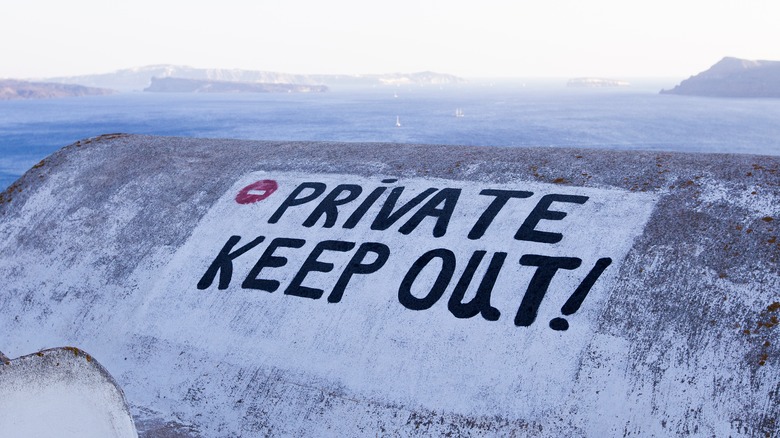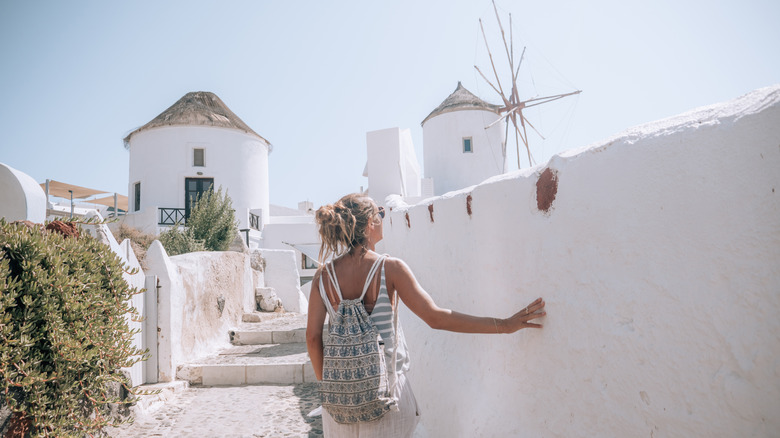The Popular Photo Op Tourists May Want To Avoid In Santorini To Not Offend Locals
Imagine living in a beautiful small town. One day, you step onto your veranda to enjoy a cup of coffee, as you always do. You hear chatter from above and, looking up, see a group of tourists walking all over your roof, snapping photos. Frustrated, you kindly ask them to leave. The next day, more tourists come. The day after, even more. Soon, your neighbors begin having the same problem with trespassing tourists standing on their roofs, selfishly capturing travel shots. This is not a dream; it is a nightmare. Unfortunately, this nightmare is a reality for the residents of the Greek island of Santorini.
With its blue-domed churches, stunning caldera views, and the absolute best place to watch the sunset, Santorini is a bucket-list destination for many travelers. The island's charm has made it one of the most photographed places in the world, especially the picturesque village of Oia. So much so that around 2 million tourists (via Greeka) visit every year — that's a lot for a 35-square-mile island with 15,000 permanent residents. That's a ratio of 133 tourists per local!
Amidst overtourism and the quest for the perfect Instagram shot, the concerning trend of tourists climbing onto the roofs of local buildings has emerged. While these photos might seem like a harmless way to capture the beauty of Santorini, they are causing significant issues for the local community. Understanding why this practice is problematic is essential for anyone planning a visit to this idyllic Greek island.
Why standing on roofs in Santorini is a bad idea
Santorini's unique Cycladic architecture, characterized by low-rise whitewashed buildings and vibrant blue accents, creates an irresistible backdrop for photos. The rooftops, in particular, offer elevated views over the volcanic island, making them a popular spot to snap the perfect picture. Rick Steves notes that social media has changed travel forever, so it's unsurprising to see photos of tourists perched on rooftops, gazing out over the Aegean Sea. However, visitors neglect to realize that these spaces are not public property — they are private homes and businesses that belong to real people.
For the 15,000 residents of Santorini, the influx of millions of tourists, many of whom climb onto their roofs, is more than an inconvenience; it is a disruption of their daily lives. The presence of roof-climbing strangers invades the residents' privacy, who might find the tourists peering into their homes, dirtying their property, or worse. Some Santorini buildings are centuries old and were not designed to handle the constant foot traffic of visitors. This leads to structural damage, causing costly repairs that are left to the owners to handle.
In Greek culture, as in many others, respecting private property is paramount. By trespassing, tourists show disrespect for Santorini customs and break local laws. No one wants their home exploited for the sake of social media likes, and local islanders are rightfully developing a sense of resentment. Santorini roofs often have signs that say "don't climb," "private property," and "keep out!"
Alternative photo opportunities in Santorini
In addition to the impacts on locals, the selfish and ignorant practice of climbing (trespassing) onto roofs poses significant safety risks. These vaulted rooftops are not intended to be used as viewing platforms and, more often than not, lack the necessary safety measures to prevent accidents. Trespassers may find themselves slipping on the smooth surfaces or losing their balance, leading to potentially severe injuries — all for that "perfect" picture. You can only imagine navigating to a hospital through the narrow, winding, overcrowded streets of Santorini after an unexpected rooftop accident.
For those who want to capture stunning views without offending locals or risking their safety, there are plenty of alternatives. Numerous viewpoints and terraces throughout the island offer incredible panoramas without the need to trespass. Many hotels and restaurants even have designated viewing areas for tourists. Some of the more photogenic locations in Santorini, like the three blue domes in Oia, the Anastasis Church in Imerovigli, and the three bells of fire in Firostefani, will require you to line up in queues — which you can decide for yourself if it's worthwhile or not.
Otherwise, ditch the run-of-the-mill photo-op spots and find other unique locations for pictures on the island — it's full of them. Ultimately, visitors can still get their coveted photos while showing respect for the local community. If you don't want hordes of tourists standing on your roof, avoid doing it in Santorini — and other cheap and uncrowded Greek islands offering stunning scenery.


